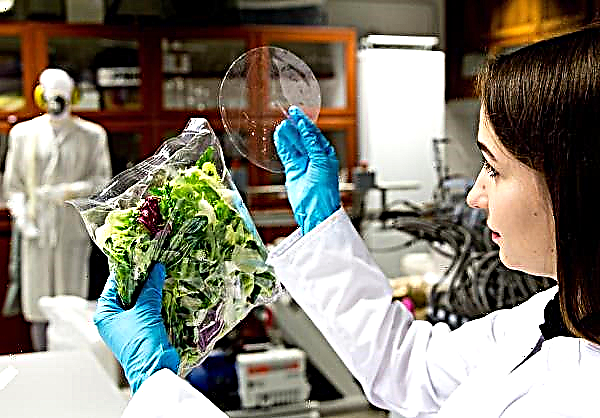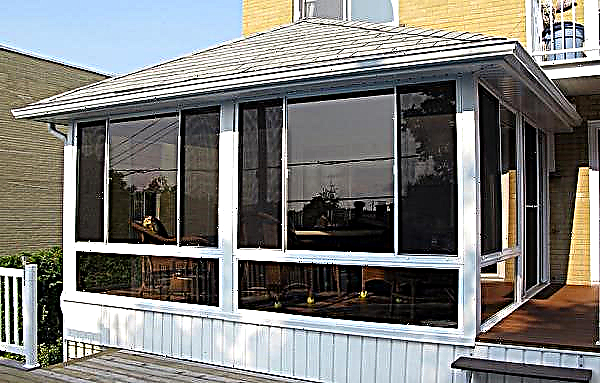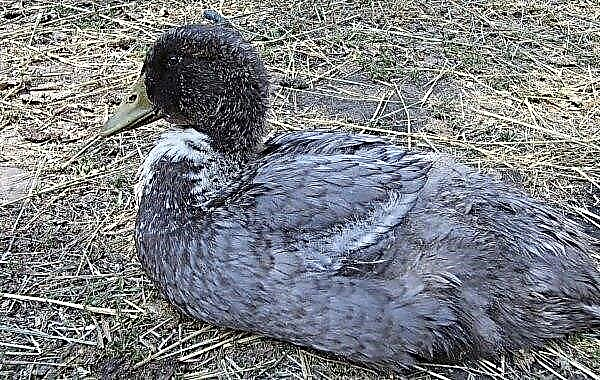Royal Strelitzia is called a bird of paradise, because it captivates with its extraordinary beauty and similarity to a bird's head crowned with a bright crown. The pleasant impression is enhanced by the strong fragrance emanating from the plant. In the article we will talk about the features of growing this spectacular flower and caring for it.
Botanical description of the plant
Strelitzia (Strelitzia) is a tall flowering perennial belonging to the Strelitzia family. Her native places are South Africa. An unusual look to this tropical plant gives a yellow-blue inflorescence, similar to the head of an exotic bird with an pointed beak and colorful crest, towering on a sturdy peduncle. Usually only an adult flower blooms, and blooms for a long time.
Inflorescences-buds (4-5 cm long) really look like an elongated feathered beak. At the top, the beak slowly opens, and flowers appear on the side of the petiole. Each bud has up to 10 brightly colored flowers filled with fragrant nectar. Strelitzia alternately produces over 6 peduncles, as a result of which the culture can bloom for up to 6 months.
Did you know? Cutting off the strelitzia for a floral arrangement, you get a persistent, effective and elegant bouquet that can stand in a vase for a month.
In the natural environment, the culture is quite tall - grows from 2 to 9 m. In the apartment, flower growth is more modest - individual plants grow up to 1.5 m. Strelitzia has a decent frame of a peduncle - leaves over 40 cm in length and 20 cm in width, leathery , elongated, ribbed, bluish-green hue, the reverse side of which has pink streaks. Leaf plates are assembled into rosettes growing directly from the root trunk. Strelitzia root - in the form of a rod, is able to take root very deeply in the ground.
The table describes the characteristic features of the described culture:
| Root system | in the form of a core |
| Stem | absent (young leaves grow from the root) |
| Leaf shape | elongated oval |
| Leaf color | gray-green |
| Flower shape | tall peduncles collected in inflorescences |
| Flower color | yellow blue or orange blue |
| Fruit shape | round |
| Fruit color | black-brown seeds covered with orange pile |
| The taste of fruit | inedible |
House growing conditions
For the health of the royal Strelitzia and preservation of its decorative appearance, it is necessary to organize acceptable conditions.
Did you know? Botanists consider the royal strelitzia a low-toxic representative of the flora, since the juice of its foliage is conditionally poisonous, and the flowers are not edible. However, making bouquets from it, they can be placed only in places inaccessible to children and pets.
Location and Lighting
The main conditions for success in the cultivation of the described plant is the availability of sufficient natural light and a large space.
Some more requirements for placing Strelitzia in an apartment:
- the presence of bright sunlight in the morning and evening hours;
- ambient light at lunchtime;
- fresh air is good for the plant, which helps the culture to bloom (can be taken out to the loggia or to the kindergarten, protecting from winds, drafts and burns of sunlight);
- placement of small flowers on the windowsill from the western and eastern sides;
- arrangement of large flowerpots with large plants on a stand (table) so that its leaves are higher than the windowsill (for better absorption of daylight);
- in winter time (November - February) extend for plant daylight hours using phytolamps (at least 12 hours).

Temperature
Room temperature is quite suitable for strelitzia in the spring-summer period, and during winter dormancy temperature indicators should be slightly lower.
Acceptable temperature indicators for plants at different times of the year:
| Season | Temperature |
| Spring | moderate, +20 ... + 22 ° C and more |
| Summer | moderate, high +25 ... + 35 ° C (with sufficient watering) |
| Fall | moderate, +20 ... + 22 ° C |
| Winter | low, +12 ... + 16 ° C |
Important! If you plan to bloom Strelitzia for the New Year holidays, it is necessary to sharply reduce its temperature to +12 ... + 14 ° C in the autumn, but in no case less.
Air humidity
A tropical flower needs high humidity, especially in the warmer months.
The table shows the humidity indicators for Strelitzia seasonally:
| Season | Humidity |
| Spring Summer | High, 75%. Careful spraying of the leaves is necessary (without contact with the flowers). Place the flowerpot on wet peat or moss, on a pallet with wet stones. Located next to the flowers: containers filled with water; aquarium; fountain; electric humidifier. |
| Autumn winter | Moderate, 55–65%. Wipe the sheets with a damp rag. It is not permissible to place flowers near radiators. |
Home Care
Royal Strelitzia differs from other exotic plants grown at home with simple and time-consuming care. But nevertheless, for its special showiness and a long flowering period, proper care is necessary.

Watering
Strelitzia, like a tropical plant, loves seasonal watering.
Strelitzia is watered according to the following rules:
- from March to September, regular and plentiful irrigation with settled and demineralized water (t +18 ... + 25 ° C) is organized for the flower;
- in hot weather, an earthen coma should not be completely dry: the soil should dry out only slightly from above;
- watered with lower watering through pallets;
- after 1 hour, excess fluid is drained from the pallets to avoid stagnation and waterlogging of the roots;
- in autumn and winter, watering is minimized (once every 2 weeks), allowing the earthen mixture in the pot to dry completely (this is the key to successful flowering in the next season).
Important! Strelitzia root folds into a spring as it grows, and is able to push a plant out of a flowerpot. Therefore, it is important to transplant the culture in a more spacious container on time.
Top dressing
Fertilize the flower using the following technology:
- in the season of active vegetation, fertilizers are applied according to the following scheme: 1 time in 2 weeks, alternating organic and mineral dressings (with nitrogen, potassium and phosphorus in the composition), or use complex dressings for indoor flowering plants (according to the instructions);
- preferable feed the plant with liquid dressingsusing them during watering;
- they don’t feed Strelitzia in winter.
Pruning
Royal Strelitzia does not have a main shoot, its leaves sprout directly from the root system, so pruning of the plant is done for hygiene reasons, removing deformed or old leaves, cutting them off at the base of the bush. This contributes to the emergence of a new shoot.

Transfer
When transplanting this tropical representative, you need to be careful, since Strelitzia has a very large and fragile rod root.
Transplantation is carried out according to the following rules:
- adult flower should be transplanted once every 3 years;
- transplant time - as needed;
- because of brittle roots, it is preferable to transplant the plant by transshipment;
- for a large plant, you will need a high (due to the characteristics of the root trunk) and a spacious flowerpot or tub (in a spacious pot, a large strelitzia will bloom faster);
- heavy, loamy, nutritious soil is used for transplantation (1 part of sand + 2 parts of sod land + 1 part of compost + 1 part of humus).
Step-by-step transplant process:
- Choose a high capacity, slightly larger than the previous one.
- Lay a drainage layer of pebbles or expanded clay (4-5 cm) at the bottom.
- Cover the drainage layer with a small layer of substrate.
- Turn the flowerpot with the plant, and holding the arrow between the fingers, and holding the soil with your palm, remove the flower from the old pot.
- Place the plant in a new container, and sprinkle with soil on the sides, slightly tamping it.
- Slightly pour on top of the earthen lump in a new pot.

Breeding
Strelitzia can be propagated in several ways:
- lateral processes;
- dividing the bush;
- sunflower seeds.
Lateral processes
From time to time, root offspring with roots appear on the culture, which can be carefully separated and transplanted into separate containers.
Transplant Process:
- Prepare suitable pots for transplanting processes.
- At the bottom of the pots pour drainage.
- Soil is laid on top of the drainage, and seedlings are planted.
- Pots with planting material are kept at a temperature of + 22 ° C.
- It is necessary to monitor moderate soil moisture in pots.
- Planted plants in this way will not grow very quickly, and flowering can only be expected after 2.5–3 years.

Dividing the bush
The powerful root stem of a crop often produces overgrowth of new rosettes, which are used to produce individual plants. Division of bushes can be done after flowering, combining with transplanting.
Division process:
- Prepare a soil mixture: compost, peat and river sand.
- Fill the substrate in containers with a diameter of 15–20 cm and moisten it.
- Get the plant with shoots from the pot.
- Separate new outlets with roots by cutting with a sharp knife, sprinkling slices with cinnamon or charcoal.
- Plant dividers in containers without tamping the soil heavily.
- Pour the soil in pots lightly from above.

Seeds
In everyday life, planting royal strelitzia with fresh seeds is considered the most optimal way. When buying a bag with planting material in the store, you must check their expiration date - it is 3 months from the date of collection.
Planting a crop with seeds is carried out in the following order:Did you know? Bright and large Strelitzia flowers attract not only insects for pollination, but also small birds, such as hummingbirds.
- Take water warmed up to + 40 ° C and soak the seeds for a day, keeping the indicated temperature constant.
- During the process of swelling of the seed material, a substrate is prepared: 1 part of peat, river sand and compost.
- In plastic cups (250 g), drain holes are made with a hot rod.
- Glasses fill a third of the soil, which is shed with boiling water and allowed to cool the ground.
- In each glass on top of the soil mixture, another 2 cm of sand is poured, and 1 seed is placed in them so that the back of the seed slightly rises above the soil.
- Place containers with seeds in a bright and warm place (temperature +22 ... + 24 ° C).
- Cover the cups with a film and leave for seed germination for 45–180 days.
- Grown seedlings are carefully planted in suitable pots, being careful not to damage the delicate roots.
Video: growing Strelitzia seeds
Growing difficulties
Although there are practically no difficulties with growing Strelitzia, flower growers sometimes encounter some problems arising from improper care or from attacks on flower pests.
Why does not bloom
The tropical culture described usually blooms at the age of 4. But it happens that this does not happen after this period.

The reasons may include the following factors:
- Inadequate intake of nutrients during the growing season. Strelitzia loves good dressing every 2 weeks, so she needs to ensure the regular supply of complex fertilizers intended for flowering indoor plants.
- Inappropriate pot size. If a flower develops in a tank too large for it, then it will not bloom until its roots completely absorb the soil in the pot. If the tank is too tight, then the root can abut against its walls or crawl out through the drainage hole. To correct the situation, the flower needs to be transplanted into a suitable pot, after which flowering can occur only after a year.
Video: how to make royal strelitzia bloom
To stimulate flowering, “shock therapy” can help - a change in the temperature of the flower. To do this, in early spring, the culture is taken out for a day in a cold room (porch or loggia), where there is a rather low temperature - about +12 ... + 13 ° C. After a day, the flower is again moved to normal conditions, with good lighting and a higher temperature. Soon, Strelitzia will actively throw out color.
Disease
If the norms of temperature and water regimes are not violated, then Strelitzia is rarely exposed to diseases. Otherwise, disturbances in care provoke diseases of the root system or leaves.
Possible diseases of Strelitzia:
- Dark spots on the leaves, as well as root rot. The cause may be excess moisture in the roots. It is necessary to check the presence of a drainage layer in the pot, as well as whether there is any stagnation of water in the pan. Perhaps the plant is watered more often than necessary. To correct the situation, you need to cut off the affected leaves, and remove the rotten roots, after removing the flower from the pot. Sprinkle places of cuts with crushed activated carbon. The plant itself needs to be moved to a different substrate.

- The dried tips and edges of the leaves. The room may have excessive air dryness. To solve the problem, a flower is regularly sprayed or an air humidifier is used, and the flowerpot itself is placed on a pallet with wet expanded clay.

- During flowering, the plant drops buds. The problem can happen due to the frequent rearrangement of the flowerpot with the flower in different places. The described culture does not tolerate if it is disturbed during the period of active flowering.

- Withered and yellowed leaves. Perhaps the plant freezes in the room where you located it. The lowest permissible temperature is + 12 ° C (in winter), so the culture will need to be transferred to a room where the mercury column is slightly higher than the specified limit.

Pests
When keeping Royal Strelitzia clean, with an acceptable level of humidity and at a suitable temperature, one should not be afraid of being infected with parasites. Nevertheless, it is necessary to periodically carefully inspect the culture for pests.
The following parasites can harm Royal Strelitzia:
- Thrips. Affect the bottom of the leaves. The leaves outside are covered with small bright dots, after which they fade after a short time. Solution: the affected leaves are removed, and the entire flower is treated with insecticidal preparations (Intavir, Decis, Actellik).

- Spider mite. The presence of insects on the plant is accompanied by the appearance of small pale yellow spots on the leaves, after which the leaves die. Solution: flush the parasite in the shower; spray with Actellik insecticide.

- Shield. Brownish or yellowish spots form on the bottom of the leaves. Solution: with a sponge or rags to remove insects that are under the specks. Then treat the flower with “Aktara” or “Confidor” insecticides. For preventive purposes, soap foam from laundry soap is applied to the leaves and left for 1 hour. Then wash off the foam with a warm shower.

- Mealybug. The leaves and their stems are covered with white fluffy lumps under which pests hide. As a result, the leaves become sticky to the touch, and then turn yellow and fall off. Solution: pests must be destroyed manually, and the plant should be treated with “Aktara”, “Confidor” or “Fitoverm”. After 7 days, the procedure should be repeated.
























